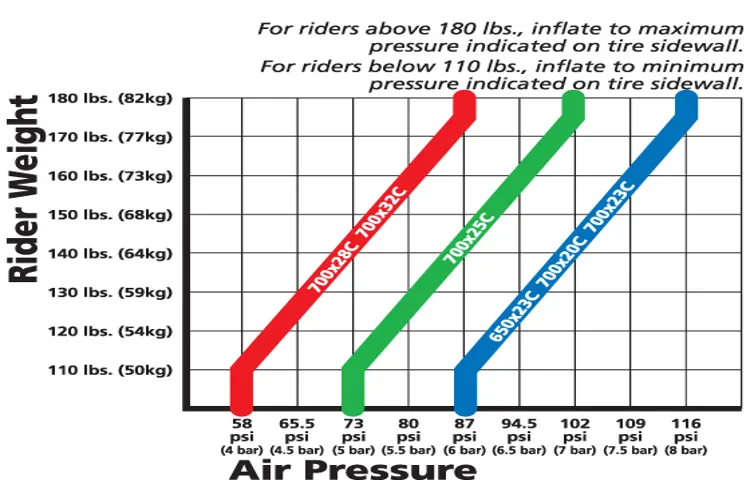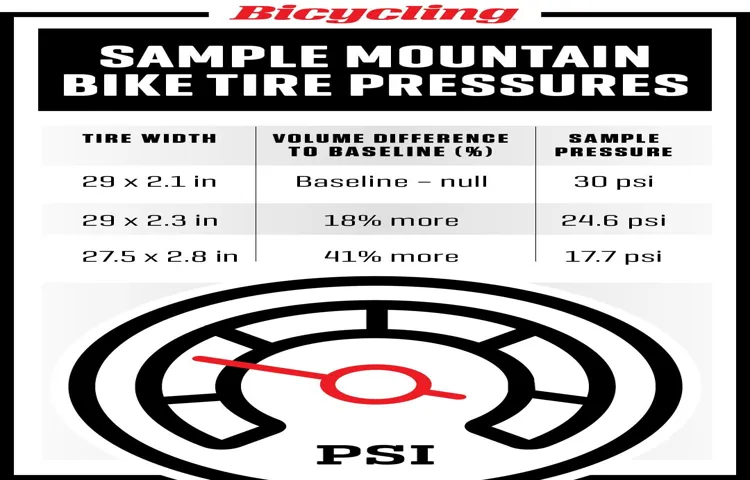When it comes to maintaining a vehicle, there are several things to keep in mind for optimal performance and safety. One of the most important things to consider is the tire pressure. Making sure that your tires have the recommended pressure is crucial to ensure they can handle the weight of the vehicle and provide maximum traction on the road.
So, what is the recommended tire pressure for a vehicle with a maximum PSI of 80? The answer is not as straightforward as one might think. The recommended tire pressure can vary depending on several factors, including the weight of the vehicle, the type of tires you have, and the driving conditions. In general, most vehicles with a maximum PSI of 80 will have a recommended tire pressure of around 35-40 PSI.
However, it is always a good idea to consult your vehicle’s owner manual to find the exact recommended tire pressure for your specific make and model. Maintaining the correct tire pressure can not only improve your vehicle’s performance and safety but also increase its fuel efficiency. Underinflated tires can cause the engine to work harder, resulting in decreased gas mileage and increased wear and tear on the vehicle.
Remember, taking the time to regularly check your tire pressure and maintain it at the recommended level can make all the difference in ensuring a smooth and safe ride. So don’t wait, head to your local auto shop or gas station and give those tires a little love and attention.
Table of Contents
What Is Tire Pressure?
Tire pressure refers to the amount of air that is in your vehicle’s tires. Maintaining the correct tire pressure is crucial for your vehicle’s performance, safety, and fuel efficiency. If your tires are overinflated, they will wear out more quickly and may become more prone to bursting.
Conversely, underinflated tires can lead to poor handling, decreased fuel efficiency, and even blowouts. Therefore, it’s important to follow your vehicle’s manufacturer’s recommendations for tire pressure, which can be found in your owner’s manual or on a sticker inside the driver’s door. For a vehicle with a maximum tire pressure of 80 psi, the recommended tire pressure can vary depending on the model and type of tire in your vehicle.
It’s always best to consult with a professional or refer to your owner’s manual for specific recommendations. By maintaining the correct tire pressure, you’ll help ensure your vehicle performs optimally and you won’t have to worry about any preventable issues on the road.
Why is Tire Pressure Important?
Tire Pressure Tire pressure is a crucial factor to consider when it comes to road safety and tire lifespan. It refers to the amount of air pressure inside a tire, typically measured in psi (pounds per square inch). Proper tire pressure is important for several reasons.
First and foremost, it ensures that your tires have enough grip on the road. When tire pressure is too low, there is less contact between the tire and the road, resulting in poor handling, longer stopping distances, and increased risk of accidents. On the other hand, overinflated tires have less traction on the road, making them more prone to slipping and skidding, especially in wet conditions.
Additionally, maintaining the proper tire pressure can improve fuel efficiency, as low tire pressure can cause the engine to work harder and consume more fuel. It also helps to extend the lifespan of your tires, as underinflated tires are more likely to wear out quickly and evenly. Therefore, it is important to regularly check your tire pressure and adjust it accordingly, based on the manufacturer’s recommendations.

How to Check Tire Pressure?
If you’re wondering what the recommended tire pressure is for an 80 psi max, it’s important to note that every vehicle has its own optimum tire pressure, so it’s best to check your car’s manual or tire placard for specific information. However, a general rule of thumb is that most standard tires require a pressure of around 30 to 35 psi. To check your tire pressure, first, ensure that your tires are cold and haven’t been driven on for at least an hour.
Next, remove the valve cap from the tire and place the pressure gauge onto the valve stem, pressing down until you hear a hissing sound. Check the pressure reading and compare it with the recommended pressure. If your tire pressure is below the recommended level, use an air compressor or a tire inflator and pump the tire until it’s at the right pressure level.
Overall, regularly checking your tire pressure can prolong their lifespan and improve fuel efficiency while also ensuring your safety on the road.
Recommended Tire Pressure for 80 PSI Max Tires
If you’re wondering what the recommended tire pressure for 80 PSI max tires is, it’s usually around 75-80 PSI. However, it’s always best to refer to your vehicle’s manual or the tire manufacturer’s recommendations to check for the exact number, as it may vary depending on the tire model and vehicle type. Checking tire pressure may seem like a daunting and tedious task, but it’s actually quite simple.
The first step is to purchase a tire pressure gauge, which you can find at any auto parts store or gas station. Once you have the gauge, simply unscrew the valve cap on the tire, place the gauge onto the valve stem, and press down firmly until you hear a hissing noise. This will provide you with an accurate reading of the tire pressure.
Be sure to check all four tires, including the spare, and make adjustments as necessary. Remember, maintaining proper tire pressure not only improves fuel efficiency but also ensures your safety on the road.
Factors That Affect Tire Pressure
Checking tire pressure is an essential step in ensuring proper tire maintenance and improving safety while driving. Factors like weather, temperature, and altitude can cause tire pressure to fluctuate, affecting performance and handling. That’s why it’s crucial to check your tire pressure at least once a month, using a reliable pressure gauge or visiting a tire professional.
To check tire pressure, first, locate the recommended pressure for your vehicle’s tires, usually located on a sticker in the driver’s doorjamb or in the owner’s manual. Remove the valve cap from the tire’s valve stem and attach the pressure gauge to the valve, careful not to let out any air. The gauge will display the current pressure, which should match the recommended pressure.
If it’s lower, add air until you reach the right pressure, and if it’s higher, release air accordingly. Maintaining proper tire pressure can prevent premature wear and tear, improve fuel efficiency, and ensure your safety on the road.
Maintaining Proper Tire Pressure
Maintaining proper tire pressure is crucial for both the safety and efficiency of your vehicle. When it comes to tires with an 80 psi max, the recommended tire pressure may vary depending on the specific make and model of your vehicle. However, as a general rule, it is important to keep the tire pressure within the range recommended by the manufacturer.
Overinflated tires can lead to a harsh ride, decreased handling, and uneven wear on the tire tread. On the other hand, underinflated tires can cause decreased fuel efficiency, poor handling, and increased risk of blowouts. To ensure that you are maintaining the proper tire pressure for your 80 psi max tires, it is recommended to check your tire pressure on a regular basis using a tire pressure gauge.
This simple task can not only improve your vehicle’s safety and performance, but it can also save you money on fuel costs and tire replacements in the long run. So, don’t overlook the importance of proper tire pressure maintenance and keep your wheels rolling smoothly and safely.
When to Check Tire Pressure
Maintaining proper tire pressure is an essential aspect of vehicle maintenance that should not be overlooked. It not only helps extend the life of your tires but also ensures optimal fuel efficiency and performance. It’s crucial to check your tire pressure regularly, at least once a month, and before any long trips or adverse weather conditions.
Any sudden temperature changes can also affect your tire pressure, which is why it’s important to keep an eye on it. Low tire pressure can cause excessive wear and tear on your tires, decrease gas mileage, and even lead to a blowout. On the other hand, overinflated tires can lead to a bumpy ride and reduce the overall stability and safety of the vehicle.
So, be sure to maintain the recommended tire pressure as outlined in your vehicle owner’s manual, and make it a habit to check them frequently for a safe and smooth ride.
Steps to Properly Inflate Tires
Maintaining proper tire pressure is incredibly important for both your safety and the longevity of your vehicle. The process of inflating tires can seem simple, but there are a few crucial steps to follow to ensure you’re doing it correctly. First and foremost, you need to find out your vehicle’s recommended tire pressure.
This information can usually be found in the owner’s manual or on a sticker on the inside of the driver’s door. Once you have this information, you need to ensure that your tires are cool before inflating. A good time to check your tire pressure is in the morning when the car has been parked overnight.
Using a reliable tire pressure gauge, check the pressure of each tire and add air as needed to reach the recommended pressure. It’s important not to overinflate the tires as this can cause them to wear down faster in the center. Conversely, underinflated tires can lead to poor gas mileage and increased risk of a blowout.
By following these simple steps, you can maintain the correct tire pressure and keep your vehicle running smoothly for years to come.
Conclusion
In conclusion, the recommended tire pressure for 80 psi max is not a one-size-fits-all solution. It’s important to consult your vehicle manual or a trusted mechanic to determine the optimal tire pressure for your specific make and model. However, if you’re feeling adventurous and want to take matters into your own hands, just remember this clever twist on an old saying: ‘When in doubt, inflate about!’ Just kidding, please don’t over-inflate your tires – always follow the manufacturer’s recommendations.
“
FAQs
What tire pressure should I maintain for a vehicle with a maximum psi of 80?
The recommended tire pressure for a vehicle with a maximum psi of 80 is typically between 32 to 35 psi.
Can I exceed the recommended tire pressure for a vehicle with a maximum psi of 80?
It is not recommended to exceed the recommended tire pressure as it can lead to reduced traction and increased risk of a blowout.
What happens if I drive with low tire pressure in a vehicle with a maximum psi of 80?
Low tire pressure can cause uneven wear on the tires, reduced fuel efficiency, and increased risk of a blowout.
How often should I check my tire pressure in a vehicle with a maximum psi of 80?
It is recommended to check tire pressure every month or before a long trip to ensure optimal performance and safety.
What are the consequences of overinflated tires on a vehicle with a maximum psi of 80?
Overinflated tires can lead to reduced traction, uneven wear, and increased risk of a blowout.
What are the benefits of maintaining proper tire pressure in a vehicle with a maximum psi of 80?
Maintaining proper tire pressure can improve fuel efficiency, reduce tire wear, and improve overall vehicle handling and safety.
How can I find the recommended tire pressure for my specific vehicle with a maximum psi of 80?
The recommended tire pressure can often be found in the vehicle owner’s manual or on a sticker located on the driver’s side door jamb.


